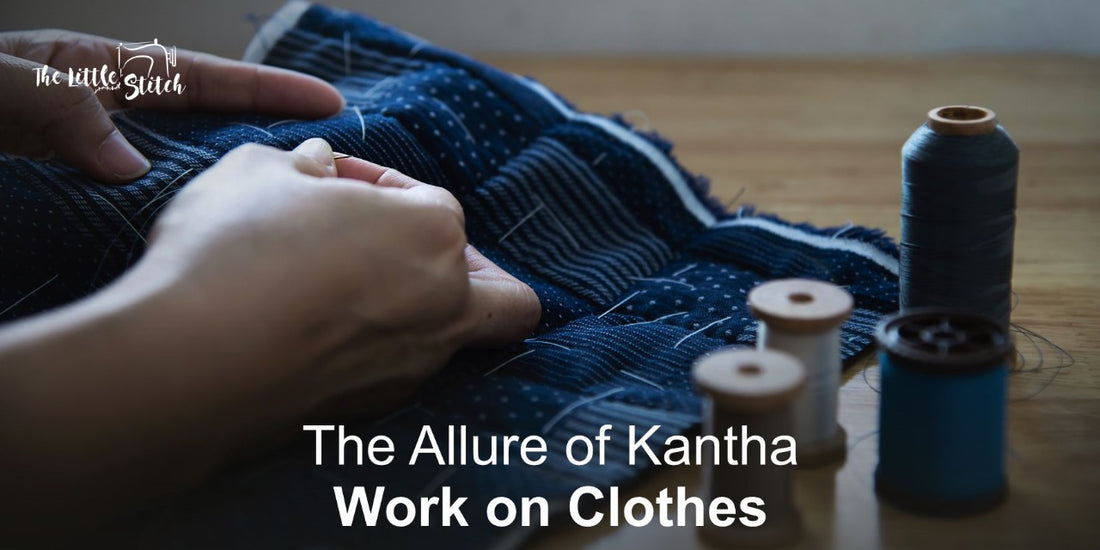
The Allure of Kantha Work on Clothes
Share
A beautiful interplay of colours, threads, and designs, Kantha is a traditional Indian work that breathes life into each cloth it adorns. Kantha is one of India’s most treasured embroidery techniques. Famous for its rich history and intricate designs, Kantha comes from the lands of West Bengal and now, the entire country loves the grace and beauty of this work.
If you're new to this traditional craft and you’re curious to know more about it, here’s everything you should learn about it.
What Is Kantha Work?
Kantha is a type of hand embroidery that originated in the eastern regions of India, particularly West Bengal and Odisha, as well as Bangladesh. Traditionally, it involved stitching together layers of old saris and cloth using simple running stitches to create quilts or blankets. Over time, people now use this technique to decorate clothing, accessories, and home decor items. The beauty of Kantha work lies in its simplicity, where running stitches form colourful, elaborate patterns.
The History Behind Kantha
Kantha embroidery goes back over 500 years. The craft finds its roots in the rural communities of West Bengal. Historically, Kantha used to take centre place in the practices of sustainability. The women would often recycle old fabrics. They stitched them together with colourful thread, turning worn-out clothes into beautiful, functional quilts. Thereon, over time, Kantha developed into an art form where each intricate pattern told stories of everyday life, folklore, and nature.
While initially a form of recycling, Kantha has evolved into a celebrated art practised by skilled artisans. Now, it particularly decorates fabrics like saris, dupattas, and even modern fashion items like jackets, bags, and dresses. At The Little Stitch also, we work with artisans from the communities to adorn your kid’s clothes with functional and beautiful Kantha stitches.
The Process of Creating Kantha Work
Traditional Kantha work is primarily done by artisans by hand. The process is labour-intensive and requires precision and creativity. Here’s how it typically unfolds:
- Preparing the Fabric: Traditionally, layers of old fabric are stitched together, but nowadays, Kantha is done on new fabrics like cotton, silk, or linen.
- Drawing the Design: Before artisans start the craft’s stitching process, they sketch out the requisite design on the fabric. Usually, these designs are inspired by nature. These include flowers, leaves, and animals. But now, more modern aesthetics like geometric shapes and patterns or motifs like dhols and flutes are also incorporated.
- Stitching: The most distinct, or the actual feature of Kantha work is its running stitch. The artisans stitch along the design outline using vibrant threads. And, depending on the intricacy, multiple colours are also often used.
- Finishing Touches: Once the artisans are done with stitching work, they wrap up the fabric to ensure that stitches last for longer. For the same, the fabric is washed, the threads are securely fastened and the cloth is dried in shade. The finished product is soft and has a beautiful, textured look.
Types of Kantha Work
Kantha work is versatile and there are many different ways it’s done. The different types that have emerged over time, based on use are:
- Lep Kantha: This is originally used for making quilts. Herein, multiple layers of fabric are stitched together with threads placed in decorative patterns.
- Sujani Kantha: This type is used to create decorative items like bed covers and cushion covers, featuring intricate designs.
- Oaar Kantha: The regular version is used for everyday items like sarees, dupattas, shawls, as well as scarves.
Why Is Kantha Work Special?
One of the most beautiful aspects of Kantha embroidery is the fact that it's entirely handmade. Each piece is actually a labour of love and a fruition of creative vision. As artisans spend hours creating one-of-a-kind designs, each piece oozes immense unique beauty. Unlike machine-made items, Kantha work reflects the skill and artistry of the person who made it, giving each piece a unique story.
